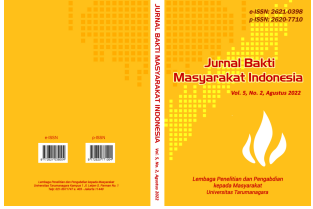APLIKASI TEKNOLOGI REACTIVE POWDER CONCRETE UNTUK MENGATASI GENANGAN AIR DI PERUMAHAN BANJAR WIJAYA TANGERANG
Main Article Content
Abstract
To help the community control rainwater puddles and anticipate flooding in the RW 07 area, Cipete Village, Pinang District, Tangerang City, the Bachelor of Civil Engineering Study Program at Tarumanagara University developed Reactive Powder Concrete (RPC) lightweight concrete technology. The program is to make concrete buis that function as infiltration wells. Infiltration wells are installed at a number of points in locations where waterlogging often occurs, have a low ground level, and are close to water drains. Three locations are the main targets for installing buis concrete infiltration wells, namely in the areas of RT 005, RT 007, and RT 003. The use of lightweight concrete buis RPC as infiltration wells is intended to withstand soil pressure; buis concrete has a compressive strength of up to 12 MPa, buis concrete is not easily broken. Apart from that, the surface of the concrete buis is made of holes. The water that enters the buis can easily flow into the ground through the surface of the concrete buis. The function of the infiltration well is to maximize the absorption of rainwater into the ground through holes on the surface of the buis, so that it does not cause puddles after it rains. The installation depth of infiltration wells ranges from 1.0 m to 70 cm, with a tidal distance between wells of 2.0 m. The installation of infiltration wells from RPC lightweight concrete has a significant impact on puddles after rain in the RW 07 area. After the concrete buis was installed, the puddles receded more quickly, 2 hours after the rain stopped compared to before the infiltration well was installed.
ABSTRAK:
Dalam upaya membantu masyarakat mengendalikan genangan air hujan serta mengantisipasi terjadinya banjir di wilayah RW 07 Kelurahan Cipete Kecamatan Pinang Kota Tangerang, Program Studi Sarjana Teknik Sipil Universitas Tarumanagara mengembangkan teknologi beton ringan Reactive Powder Concrete (RPC) untuk membuat buis beton yang berfungsi sebagai sumur resapan. Sumur resapan dipasang pada sejumlah titik di lokasi yang sering terjadi genangan air, memiliki permukaan tanah rendah, dan dekat dengan saluran pembuangan air. Terdapat 3 lokasi yang menjadi target utama pemasangan buis beton sumur resapan yaitu diwilayah RT 005, RT 007 dan RT 003. Penggunaan buis beton ringan RPC sebagai sumur resapan ditujukan untuk menahan daya desak tanah, mengingat buis beton memiliki kuat tekan mencapai 12 MPa maka buis beton tidak mudah pecah. Selain daripada itu, pada permukaan buis beton dibuat berlobang-lobang supaya air yang masuk kedalam buis mudah dialirkan kedalam tanah melalui permukaan buis beton. Fungsi dari sumur resapan tersebut adalah memaksimalkan penyerapan air hujan ke tanah melalui lobang-lobang pada permukaan buis, sehingga tidak menimbulkan genangan setelah hujan turun. Kedalaman pemasangan sumur resapan berkisar antara 1,0 m sampai dengan 70 cm dengan jarak pasang antar sumur sebesar 2,0 m. Pemasangan sumur resapan dari buis beton ringan RPC memberikan dampak yang signifikan terhadap genangan air setelah terjadinya hujan di wilayah RW 07. Setelah dipasang buis beton, genangan air lebih cepat surut 2 jam setelah hujan reda bila dibandingkan sebelum pemasangan sumur resapan.
Article Details

This work is licensed under a Creative Commons Attribution-NonCommercial-ShareAlike 4.0 International License.
This work is licensed under a Jurnal Bakti Masyarakat Indonesia https://creativecommons.org/licenses/by-nc-sa/4.0/
References
Ahn, Y. B., Jang, J.G., Lee, H.K. (2016). “ Mechanical Properties Of Lightweight Concrete Made With Coal Ashes After Exposure To Elevated Temperatures”, Cement and Concrete Composite, 72, 27-38.
Ichsan, I., Hulalata, Z. S. (2018). “Analisa Penerapan Resapan Biopori Pada Kawasan Rawan Bajir Di kecamatan telaga Biru”, Gorontalo Journal of Infrastructure and Science Engineering, 1(1), 33-46.
Ju, Y., Tian, K., Liu, H., Reinhardt, H. W., Wang, L. (2017). “Experimental investigation of the effect of silica fume on the thermal spalling of reactive powder concrete”Construction and Building materials, 155, 571-583.
Juliandari, M. (2013). “Efektifitas Lubang Resapan Bopori Terhdap Laju Resapan (Infiltrasi)”, Jurnal Teknologi Lingkungan Lahan Basah. 1(1), 1-10.
Kushartomo, W., Linggasari, D., Sutandi, A. (2020). “Effek Ukuran Butiran Maksimum terhadap Nilai Modulus of Rupture Reactive Powder Concrete “, Media Komunikasi Teknik Sipil, 26 (1), 1-8.
Kushartomo, W., Octavivia. (2019). “Durability of Reacyive Powder Concrete”, The First International Conference of Construction, Infrastructure, and Materials (ICCIM 2019), Jakarta, 16-17 Juli 2019.
Kushartomo, W., Sari, D. P., Sutandi, A. (2018). “Sifat Mekanis beton Normal dengn Campuran Tepung Marmer “, Media Komunikasi Teknik Sipil, 24 (1), 71-78.
Kushartomo, W., Sutandi, A., Linggasari, D. (2020). “Memperkirakan Perbandingan kadar Air Semen Pada Beton Keras“, Jurnal Muara, Sains, Teknologi, Kedokteran, dan Kesehatan, 4 (1), 177-186.
Kushartomo, W., Wiyanto, H., Christianto, D. (2021). “Effect of Cement–Water Ratio on the Mechanical Properties of Reactive Powder Concrete with Marble Powder as Constituent Material”, The Second International Conference of Construction, Infrastructure, and Materials (ICCIM 2021), Jakarta, 26 Juli 2021, 177-186.
Kushartomo, W., Wiyanto, H., Christianto, D. (2021). “Increasing The Calcium Silicate Hydrate Amount In Reactive Powder Concrete Using Marble Powder”, Spektra, 6 (1), 25-35.
Linggasari, D., Sutandi, A., Kushartomo, W. (2018). “Pengaruh Tepung Marmer terhadap Sifat Mekanik Reactive Powder Concrete “, Jurnal Muara, Sains, Teknologi, Kedokteran, dan Kesehatan, 2 (2), 541-548.
Sadrekarimi, A. (2004). “Development of a Light Weight Reactive Powder Concrete”, Jornal of Advanced Concrete Technology, 2(3), 409-417
Sutandi, A., Kushartomo, W. (2019). “Pengaruh Ukuran Butiran Maksimum Terhadap Kuat Tekan Reactive Powder Concrete “, Jurnal Muara, Sains, Teknologi, Kedokteran, dan Kesehatan, 3 (1), 161-169.
Yohana, C., Griandini, D., Muzambeq, S. (2017). “Penerapan Pembuatan Teknik Lubang Biopori Resapan Sebagai Upaya Pengendalian Banjir”, jurnal pemberdayaan Masyarakat Madani, 1(2), 296-308.



